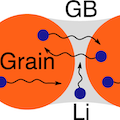Abstract
Solid electrolytes are generating considerable interest for all-solid-state Li-ion batteries to address safety and performance issues. Grain boundaries have a significant influence on solid electrolytes and are key hurdles that must be overcome for their successful application. However, grain boundary effects on ionic transport are not fully understood, especially at the atomic scale. The Li-rich anti-perovskite Li3OCl is a promising solid electrolyte, although there is debate concerning the precise Li-ion migration barriers and conductivity. Using Li3OCl as a model polycrystalline electrolyte, we apply large-scale molecular dynamics simulations to analyze the ionic transport at stable grain boundaries. Our results predict high concentrations of grain boundaries and clearly show that Li-ion conductivity is severely hindered through the grain boundaries. The activation energies for Li-ion conduction traversing the grain boundaries are consistently higher than that of the bulk crystal, confirming the high grain boundary resistance in this material. Using our results, we propose a polycrystalline model to quantify the impact of grain boundaries on conductivity as a function of grain size. Such insights provide valuable fundamental understanding of the role of grain boundaries and how tailoring the microstructure can lead to the optimization of new high-performance solid electrolytes.
